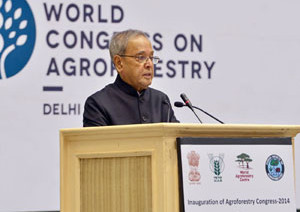
Vigyan Bhavan & Kempinski Ambience
10 - 14 February 2014
Delhi, India
blog

Following is the speech by the President of India, His Excellency Shri Pranab Mukherjee at the inauguration of the World Congress on Agroforestry:
1. It is my privilege to be here today to inaugurate the World Congress on Agro-forestry.
To begin with, let me extend a very heartly welcome to all the distinguished delegates from abroad. I wish them all a very comfortable stay in Delhi and hope they enjoy its salubrious February weather.
2. I am also happy to take this opportunity to present the Krishi Karman Awards of the Union Ministry of Agriculture, Government of India.
3. I congratulate the Indian Council of Agricultural Research, World Agro-forestry Centre and the Indian Society of Agro-forestry for jointly organizing this World Agro-forestry Congress. Being held in the Asia-Pacific region for the first time, I consider it a great honour to be a part of this historic occasion. In the context of increasing environmental degradation and rising pollution levels, the theme of this international conclave, “Trees for Life: Accelerating the Impacts of Agro-forestry” is truly relevant.
Ladies and Gentlemen:
4. Trees have been an integral part of the Indian culture and landscape from the times of yore. During the Vedic Age, which is a period in Indian history between 4500 and 1800 BC, a village would be considered complete only with its complement of woodlands in and around the houses. Surapala, an ancient scholar who lived in the tenth century India, had written Vriksha Ayurveda, or ‘The Science of Plant Life’. This text describes arbori-culture, which is the science and practice associated with the cultivation, management and study of individual trees, shrubs, vines and woody plants. Surapala’s work mentions 170 species of trees, shrubs and herbs. It also provides a comprehensive description for the treatment of seeds and planting materials; selection of land; water management; plant nutrition and control of plant disorders; laying out of gardens and orchards, and growing of rare trees. Much prior to Surapala’s account, Emperor Ashoka who ruled in the third century BC had fostered a system of arbori-horticulture.
5. Due to medicinal and aesthetic qualities, several trees and shrubs are considered sacred in India. Some like Pipal find reference in ancient religious scriptures. The Puranas extol the virtues of tree planting as and I quote: “dasha-kūpa-samā vāpī, dasha-vāpī-samo hradaḥ; dasha-hrada-samaḥ putro, dasha-putra-samo drumaḥ” (unquote), which means “a pond equals ten wells, a reservoir equals ten ponds; a son equals ten reservoirs, and a tree equals ten sons”.
Ladies and Gentlemen:
6. Tree-based production systems abound the tropical regions of the world. Yet, natural conservation has taken a backseat owing to the restless human drive towards urbanization, industrialization and food production. It has also suffered the impact of climate change, which has captured global attention now. 2014 should be a defining moment for evolving tree-based production systems to fight the debilitating impact of climate change in agriculture.
7. Instances of environmental debasement causing acute farmer distress have come to the fore in the recent past. The ecological foundations of soil, water, biodiversity and forests, essential for sustained advances in productivity, are under severe stress today. There are an estimated 500 million small-holder farms in the developing world, supporting the livelihood of about 2 billion people. These small farmers who practice family farming are economically vulnerable. Recognizing the need to reposition family farming at the centre of agricultural, environmental and social policies in the national agendas of different countries, the United Nations (UN) has declared 2014 as the International Year of Family Farming. Sustainable agricultural production systems based on the principle of environmental protection can indeed have a decisive influence in eliminating hunger and extirpating rural poverty.
Ladies and Gentlemen:
8. Agro-forestry offers a significant opening in resetting our priorities on farm sustainability. It is emerging as a major domain in environmentally sustainable food production systems. Agro-forestry system produces food, fuel and fibre; contributes to food and nutritional security; sustains livelihoods; helps in preventing deforestation; increases biodiversity; protects water resources, and reduces erosion. Carbon sequestration of agro-forestry farms is a low-hanging fruit for climate change mitigation, justifying greater investment in them. Agro-forestry is also an important alternative to meet the target of increasing the vegetation cover to 33 per cent from the present level of below 25 per cent.
9. In India, agricultural land makes up over 43 per cent of the total geographical area. Forests occupy about 23 per cent. There exists a vast potential for using agricultural land as a source of timber. It is estimated that already, about 64 per cent of India’s timber requirement is met from trees grown on the farm. Agro-forestry also meets almost half of the total demand of 201 million tonne of fuel wood in the country. Agro-forestry generates 450 labour days per hectare annually without negating farm productivity or income.
10. Though the Green Revolution helped India attain self-sufficiency in food grain production, the indiscriminate use of fertilizers and pesticides and improper land use management led to extensive environmental degradation, eventually affecting crop yield. Agro-forestry is alluring as an alternate land use option. Integration of agricultural and forest crops would not only prevent further land degradation but also ensure timber and firewood availability to the rural population.
11. The potential of agro-forestry to contribute to sustainable development has been recognized internationally as well. For instance, the UN Framework Convention on Climate Change and the Inter-governmental Panel on Climate Change have acknowledged agro-forestry as a crucial constituent of climate-smart agriculture. The UN Convention to Combat Desertification recognizes agro-forestry as a key prospect for controlling desertification and pursuing rehabilitation. The Convention on Biological Diversity views agro-forestry as a central element in its ecosystem approach for conservation of agro-biodiversity. Agro-forestry is perhaps the only land use activity that has etched a relevant role for itself in the approaches espoused by these three important UN conventions.
Ladies and Gentlemen:
12. Undoubtedly, agro-forestry holds immense promise in enhancing the productivity of land in an environmentally and economically sustainable manner. Greater research is today required in agro-forestry, focused on creating eco-technologies that purposefully blend traditional ecological prudence with renewable energy technology.
13. India has been in the forefront of research on agro-forestry. The Indian Council of Agricultural Research had initiated a network project – All India Coordinated Research Project on Agro-forestry – in 1983. It had also established a National Research Centre for Agro-forestry in 1988. The Indian Council of Forestry Research and Education has recently initiated steps for unveiling another network programme on agro-forestry. State Agricultural Universities having Forestry or Agro-forestry departments partner in these network activities. These pioneering efforts have created a critical mass of manpower in the field of agro-forestry in the country.
14. Despite the large spinoffs agro-forestry can deliver, its development is hampered by lack of policy incentives, inadequate knowledge dissemination, legal constraints and poor coordination among its beneficiary sectors. Inadequate investment, lack of suitable extension strategies and weak market linkages compound the woes of this sector. Rather than being discouraged by long gestation periods normally associated with agro-forestry projects, we need innovative models that encourage investment in this sector.
15. Agro-forestry, as a promising sector, can no longer remain constricted to our tunnel vision. I am happy at the efforts being made to elevate agro-forestry to a wider framework in our policy discourse. I am told that a draft National Agro-forestry Policy has been prepared, which I hope will be finalized soon. A National Mission on Agro-forestry has also been planned that will ensure better coordination, seek convergence and derive synergy between various players operating in the sector.
16. I am confident that this Congress will provide a platform for concrete and meaningful discussions on the agro-forestry sector. The time for ideologic sermoning is over. The cylinders can no longer remain idle. It is time to fire. With these words, I conclude. May this Congress achieve all success.
Thank you.
Jai Hind.
Picture courtesy ICAR





